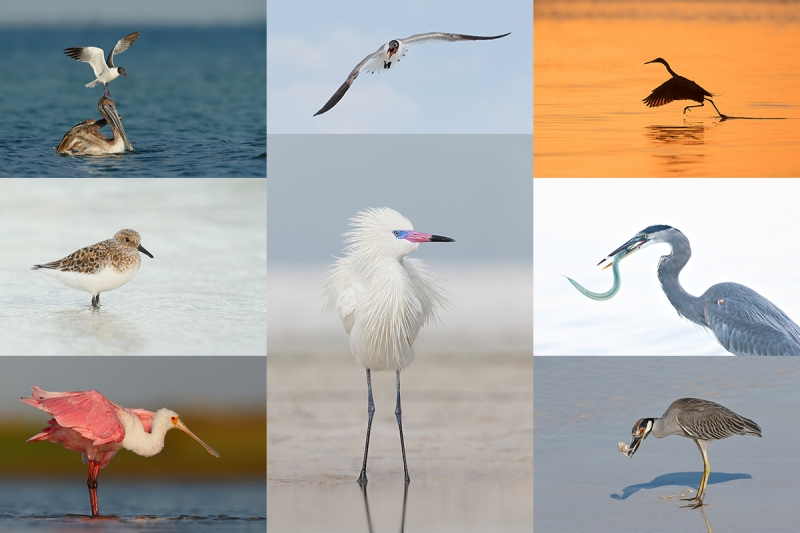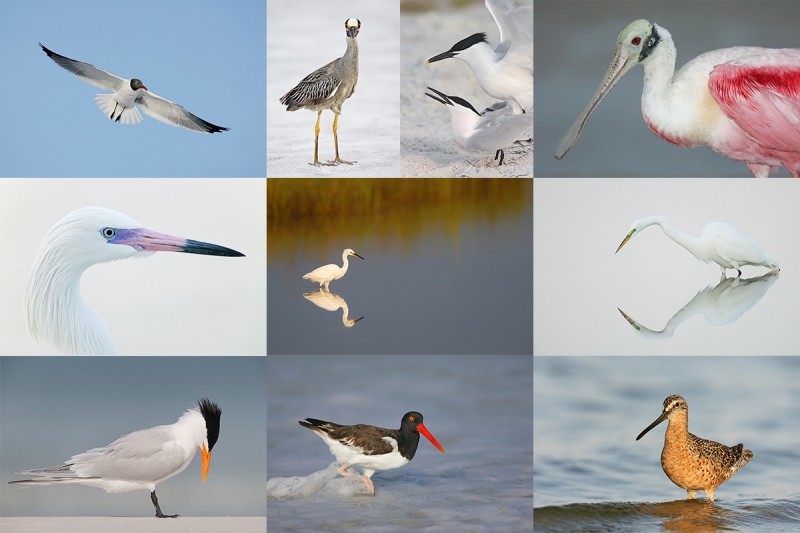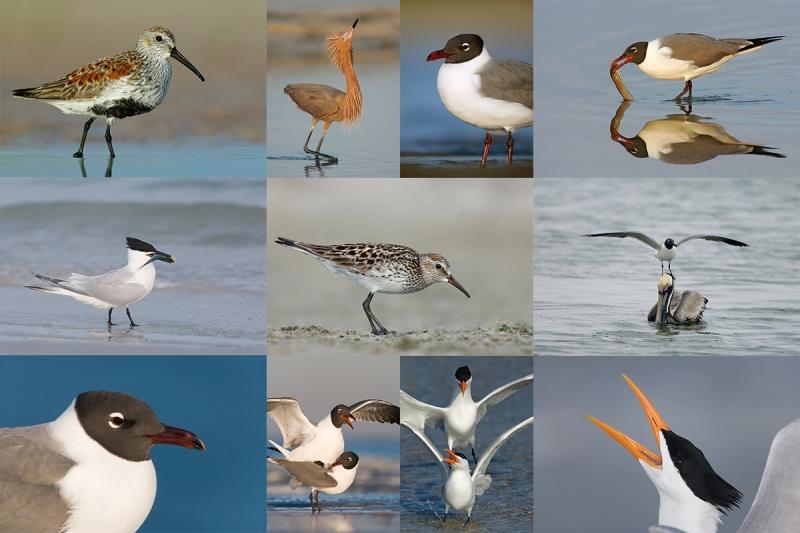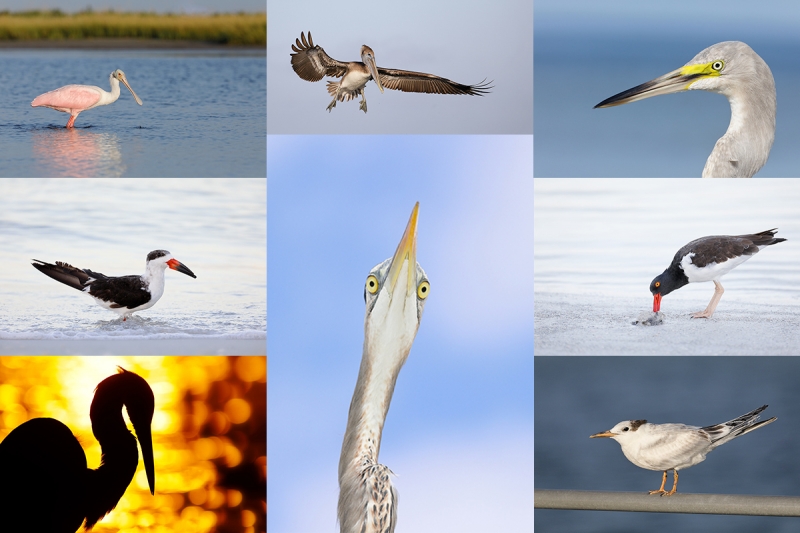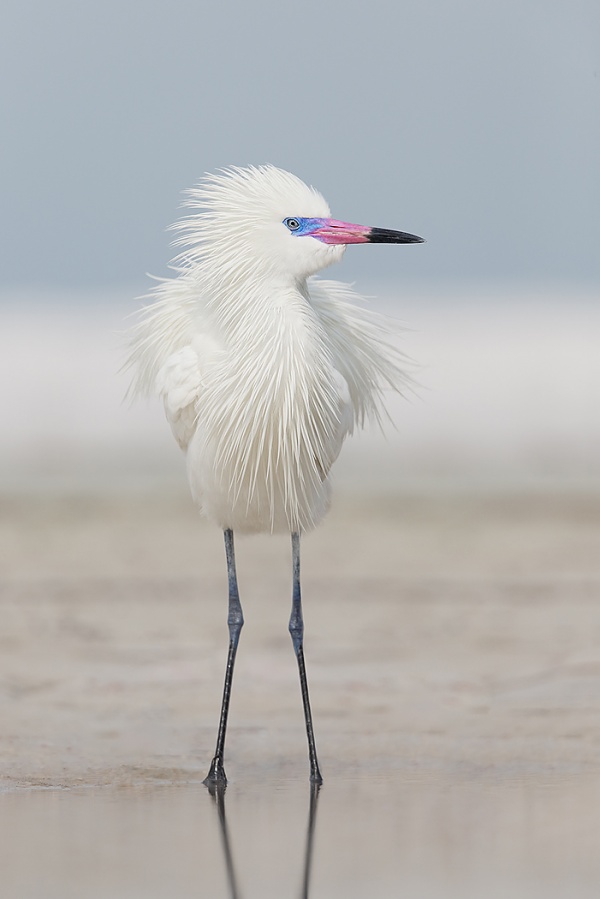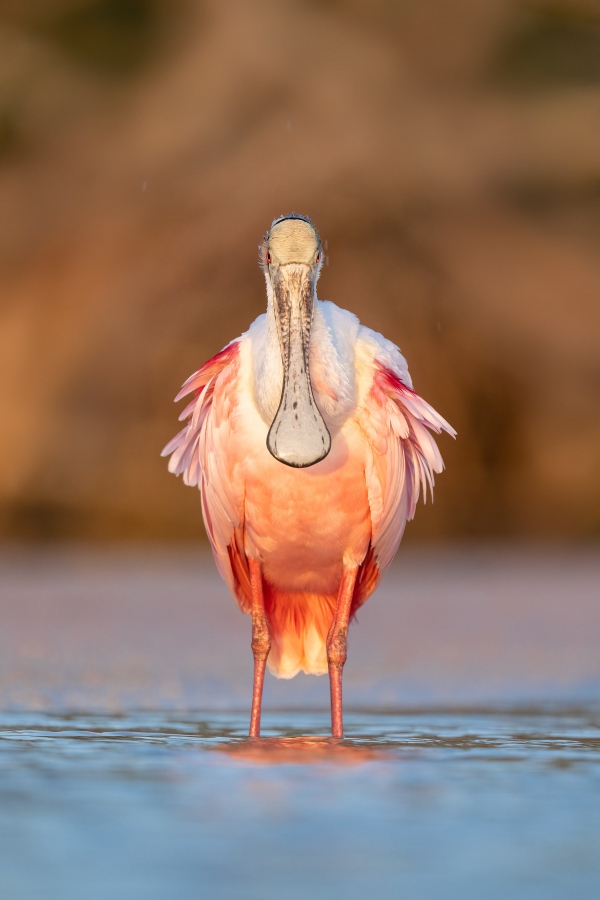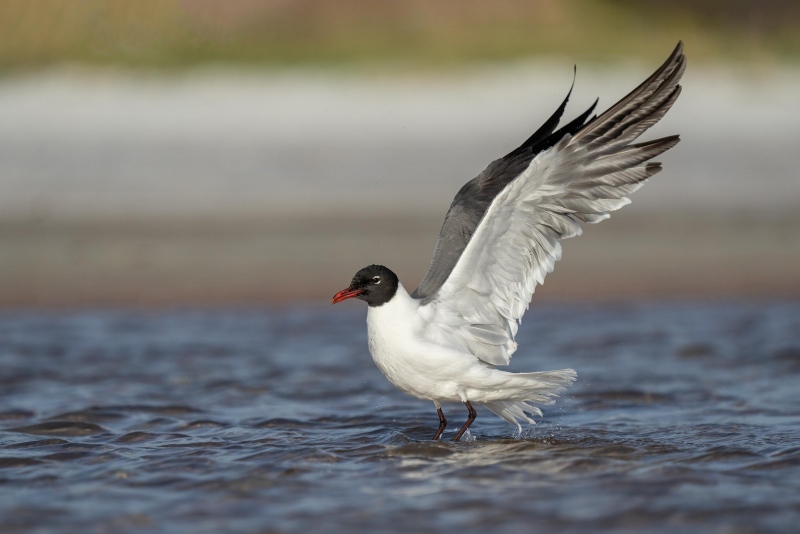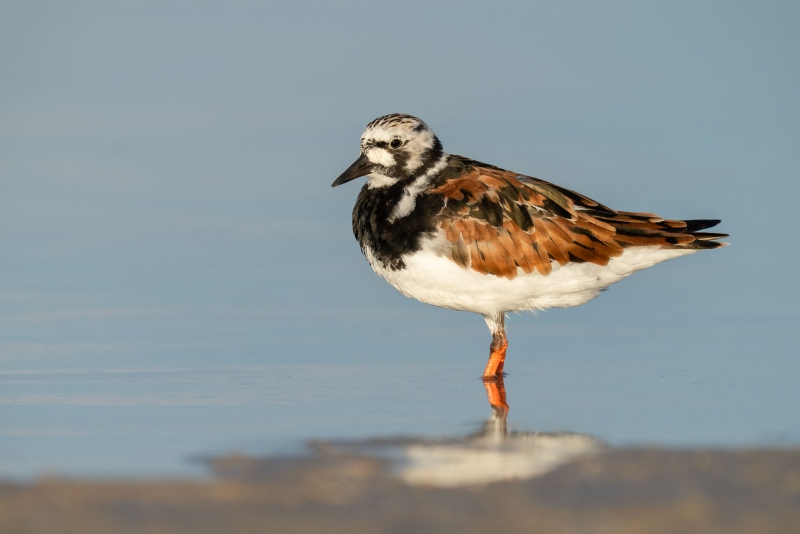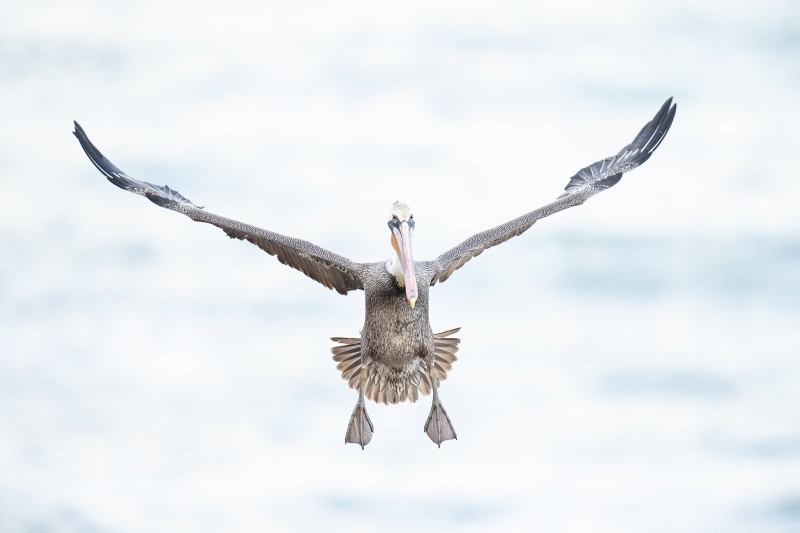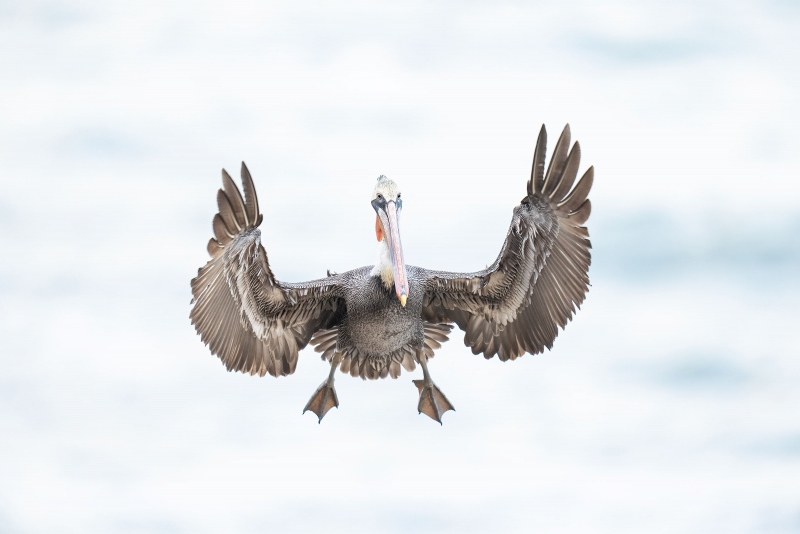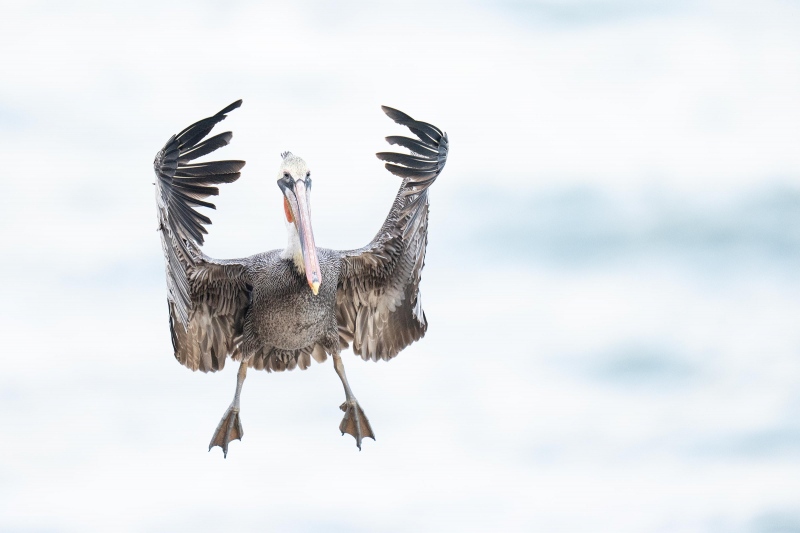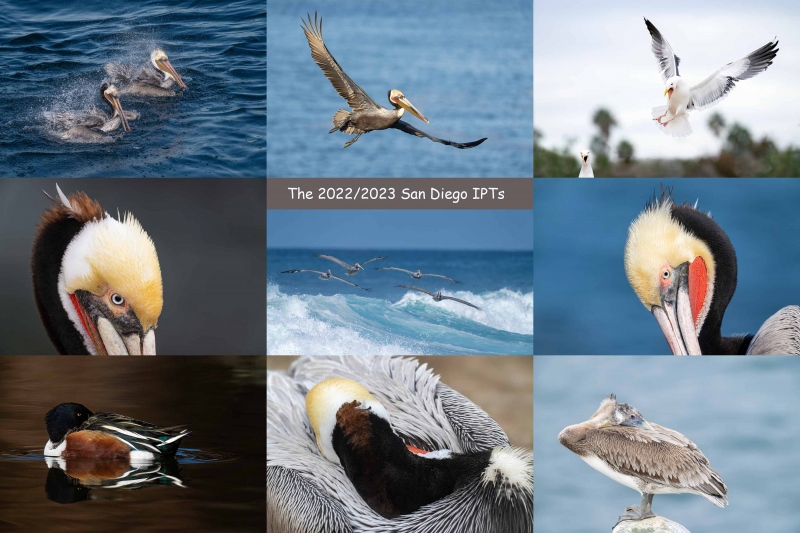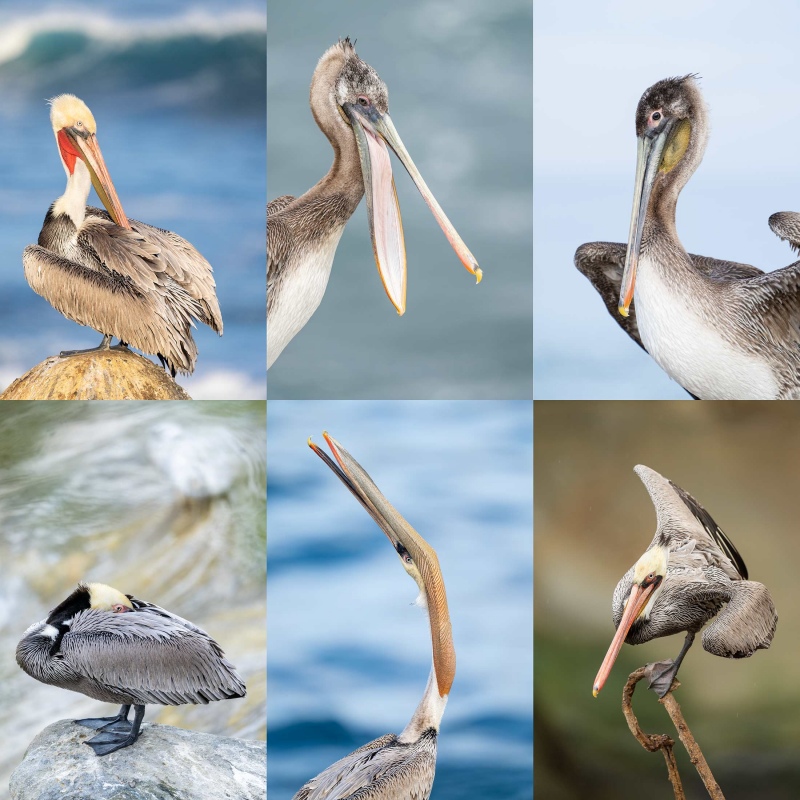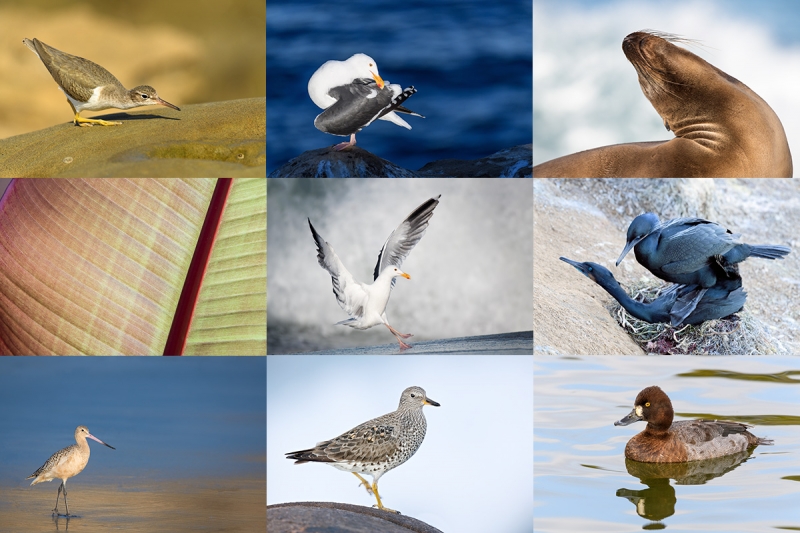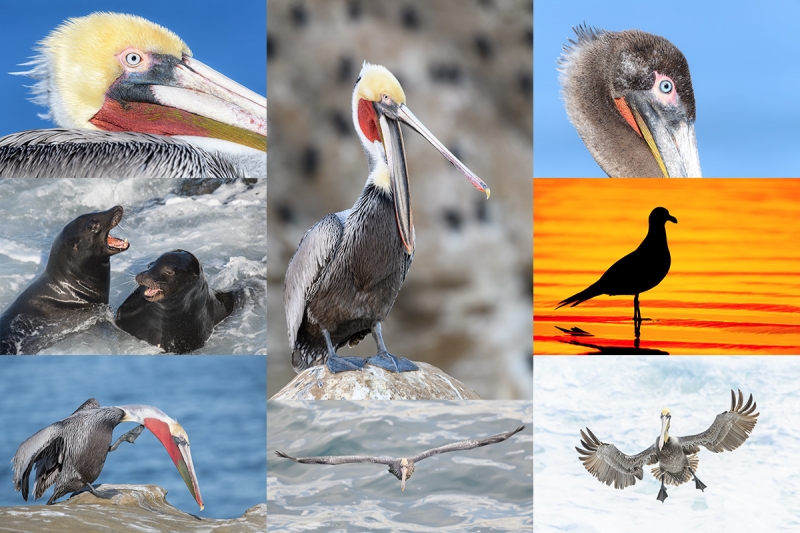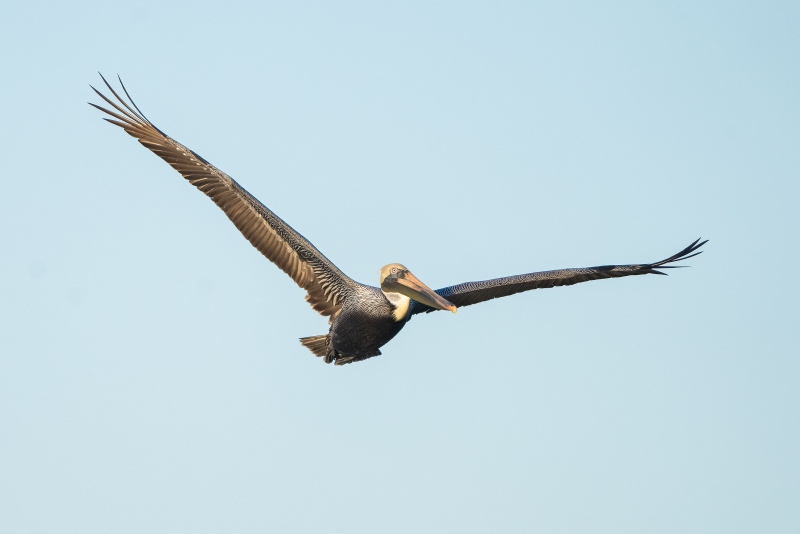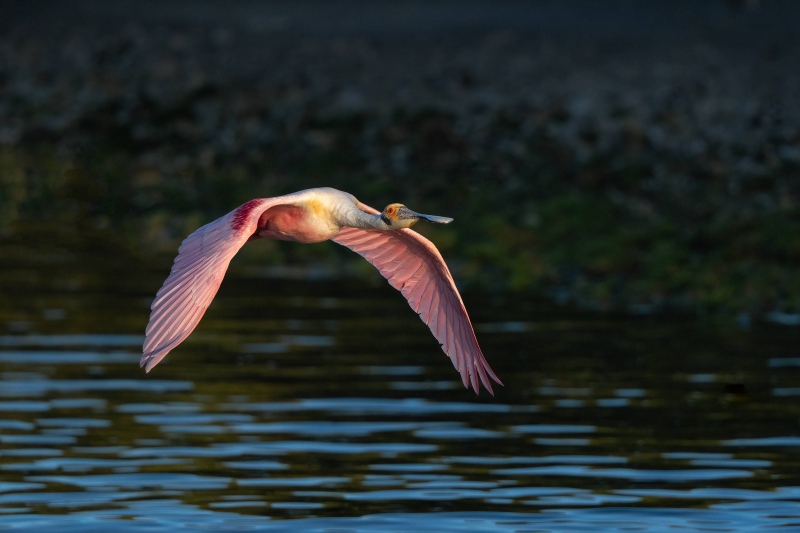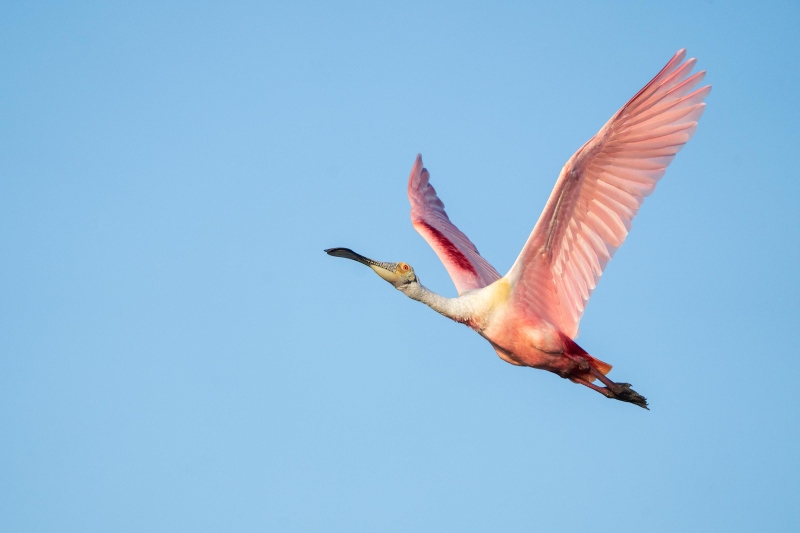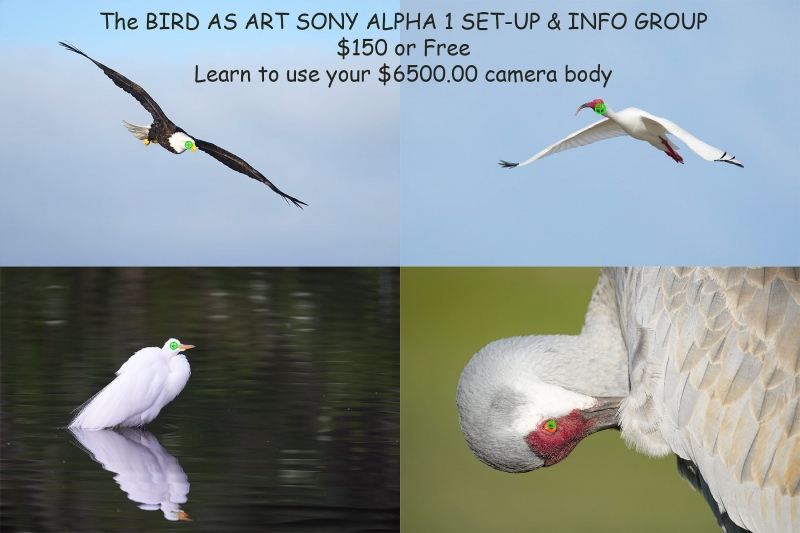February 18th, 2023 Unsolicited via e-mail from Pete Myers
I just spent 4 days in the field in a graduate course in bird photography taught by Artie Morris at Fort DeSoto. After almost 50 years of experience pointing cameras at birds from the Arctic to Tierra del Fuego, New Zealand and beyond, I thought I was good enough. But what I learned from Artie in just four days has taken me to a whole new level. As he aptly puts it, “birds as art,” not simply bird photography. One of those 4 days was the most satisfying I’d ever experienced, anywhere. The IPT left me euphoric about what I’d learned, and frighteningly committed to recreating my portfolio with the techniques and insights he taught me.
Unsolicited via e-mail from IPT veteran Eugen Dolan
Arthur, Thank you very much for your overwhelming infectious enthusiasm that helped get me up on some mornings. Also, your ability to express yourself- and explain in great detail why you like or may not like an image – was very helpful in allowing me to better analyze my images. Eugen
Via e-mail from Jim Miller
I can’t stop thinking about how much fun the DeSoto IPT was, and how much I learned. There were so many things that suddenly made perfect sense after I had been confused for so long. Thank you very much for the wonderful trip, and for being a great teacher. As I worked through the raw files last week, I realized what a fantastic lens the 600 IS is. Thanks for the rental! Maybe someday I will be able to afford one. Some images for critique are attached. Thank you again, Artie. It was really wonderful to be with you and learn from you.
Via e-mail from Lee Sommie
I want to thank you for making the Fort DeSoto IPT; it was a fun and educational experience for me. I truly did not want the adventure to end. I now look through the viewfinder with an artist’s mindset. And the real bonus was making new friends with fellow students. Thank you for sharing your knowledge and enthusiasm for wildlife photography. I had a great time with you and look forward to more adventures on future IPTs.
Via e-mail from Muhammad Arif
I had a great time at Fort De Soto. Thank you for all the instruction, for your help and pointers; my photography has already improved tremendously, and I’ve never made such good bird photos before. I wish I could’ve joined you on Monday and Tuesday morning as well, but work got in the way. It was also nice meeting the folks on the IPT. Thanks again for everything and I hope to join you at a future IPT sometime again.
|
|
|
Fort DeSoto in spring is rife with tame birds, many in full breeding plumage. Click on the composite to enjoy a larger version.
Clockwise from upper left around to center: Laughing Gull landing on head of Brown Pelican, Laughing Gull in flight, Reddish Egret sunrise silhouette, Great Blue Heron with needlefish, Yellow-crowned Night Heron with ghost crab, Roseate Spoonbill, Sanderling in breeding plumage, and white morph Reddish Egret in glorious breeding plumage.
|
The 2023 Spring Fort DeSoto Instructional Photo Tours (IPTs)
Spring Fort DeSoto IPT #1: Tuesday 28 March through the morning session on 31 March 2023. 3 1/2 Days: $1899.00 includes three working brunches. Limit six photographers.
Spring Fort DeSoto IPT #2: Tuesday 11 April through the morning session on 14 April 2023. 3 1/2 Days: $1899.00 includes three working brunches. Limit six photographers/Openings: 5.
Spring Fort DeSoto IPT #3: Tuesday 9 May through the morning session on 12 May 2023. 3 1/2 Days: $1899.00 includes three working brunches. Limit six photographers/Openings: 4.
Fort DeSoto, located just south of St. Petersburg, FL, is a mecca for terns and gulls, wading birds, and shorebirds in spring. Many of the birds will be in full breeding plumage. Simply put, DeSoto is the new Ding Darling. Migrant shorebirds are in abundance, and many are exceedingly tame. We should have great chances on Royal and Sandwich Terns and both white- and dark-morph Reddish Egrets. Great Egret, Snowy Egret, Great Blue Heron, Tricolored Heron, and White Ibis are easy as well and we will almost surely come up with a tame Yellow-crowned Night-Heron or two along with some American Oystercatchers. We will enjoy lots of great flight photography, especially with the Brown Pelicans.
|
|
|
Again, Fort DeSoto in spring is rife with tame birds, most in breeding plumage. Click on the composite to enjoy a larger version.
Clockwise from upper left around to center: Laughing Gull in flight, Yellow-crowned Night-Heron, Sandwich Terns copulating, Roseate Spoonbill, Great Egret with reflection, breeding plumage Short-billed Dowitcher, American Oystercatcher, Royal Tern, white morph Reddish Egret, and Snowy Egret in marsh.
|
In Addition!
We should also get to photograph a variety of other shorebirds including Black-bellied, Semipalmated, Wilson’s, Snowy, and Piping Plovers, Willet, Dunlin, Short-billed Dowitcher, Marbled Godwit, and most especially, Red Knot, with many individuals in their handsome breeding plumages. In spring the T-shaped peninsula and the newly formed sandbar, Outback Key, are literally packed with avian treasures.
With just a bit of luck, we may get to photograph one of Florida’s most desirable species: Roseate Spoonbill. And we will surely get to do some Brown Pelican flight photography. With luck, they will have Laughing Gulls landing on their heads. And though not guaranteed, Wood Stork might well be expected. And we will be on the lookout for a migrant passerine fallout in the event of a thunderstorm or two.
|
|
|
Yes, Fort DeSoto in spring is rife with tame birds, most in breeding plumage. Click on the composite to enjoy a larger version.
Clockwise from upper left around to center: breeding plumage Dunlin, dark morph Reddish Egret displaying, Laughing Gull vertical front-end portrait, Laughing Gull with prey item, landing on head of Brown Pelican, breeding plumage Royal Tern displaying, Royal Terns — pre-copulatory stance, Laughing Gulls copulating, Laughing Gull head portrait, breeding plumage Sandwich Tern with fish, and a rare treat, a breeding plumage White-rumped Sandpiper.
|
What You Will Learn on a DeSoto IPT
- 1- The basics and fine points of digital exposure; how to get the right exposure every time after making a single test exposure (or before if you are using SONY gear).
- 2- How and why to work in Manual mode (even if you’re scared of it).
- 3- How to approach free and wild birds without disturbing them.
- 4- Lots about bird behavior and how to use that knowledge to help you create better images.
- 5- To age and identify many species of shorebirds including various sandpipers, plovers, dowitchers, and possibly yellowlegs.
- 6- To spot good situations and to choose the best perspective.
- 7- To see, evaluate, and understand the light.
- 8- To design pleasing images by mastering your camera’s AF system.
- 9- And perhaps most importantly, to evaluate wind and sky conditions and understand how they affect bird photography.
- 10- More than you could ever imagine.
|
|
|
You got it by now! Fort DeSoto in spring is rife with tame birds, most in breeding plumage. Click on the composite to enjoy a larger version.
Clockwise from upper left around to center: Roseate Spoonbill, immature Brown Pelican in flight, the heron/egret hybrid, American Oystercatcher feeding, immature Royal Tern on railing, Great Egret morning silhouette, Black Skimmer in surf, and underside head portrait of Great Blue Heron.
|
The Details
Morning sessions will run two and one-half to three hours; afternoon sessions about two. There is never a set schedule on an IPT — we adapt to the conditions. On cloudy mornings with the right wind, we may opt to photograph till noon and skip the afternoon session. That especially when the afternoon weather is looking iffy. We may opt to visit a great North Tampa rookery if conditions warrant that.
There will be a Photoshop/Image Review session before and after brunch (included) each of the three full days. That will be followed by Instructor Nap Time. Each of these IPTs will run with only a single registrant as I do not like disappointing anyone. The best airport is Tampa (TPA). Once you register, you will receive an e-mail with lodging information. Do know that it is always best if IPT folks stay in the same general area (rather than at home or at a friend’s place a good distance away).
Folks attending this IPT will be out in the field as early as possible and stay out late to take advantage of sunrise and sunset colors; this is pretty much a staple on almost all BIRDS AS ART Instructional Photo-Tours. Doing so will often present unique photographic opportunities, opportunities that will be missed by those who need their beauty rest and those who need to get home for a proper dinner. I really love it when I am leaving the beach at 9:30am on a sunny morning after a great session just as a carful or two of well-rested photographers are arriving … We will be getting wet.
Your $599 deposit is due now. Credit cards are OK for that. You can register by calling Jim or Jennifer during weekday business hours at 863-692-0906 with a credit card in hand. Once you leave a deposit, you will receive an e-mail with your balance statement and instructions for sending your balance check three months before the trip begins. If you wish to pay in full right off the bat, you can make your check out to BIRDS AS ART and send it via US mail here: BIRDS AS ART, PO BOX 7245, Indian Lake Estates, FL 33855. You will receive a confirmation e-mail with detailed instructions, and clothing and gear advice two months before the trip. Please shoot me an e-mail if you plan to register or if you have any questions.
IPT veterans and couples or friends signing up together may e-mail for discount information.
What’s Up?
I was up early and packing like a fiend on Friday. I had thought about heading down to the lake to check on the eaglets, but it was blessedly foggy. I did have time for a swim on what seemed like a summer afternoon. Jim dropped me off at the Courtyard Marriot Airport on his way home. With the rush-hour traffic, the “1 1/2-hour” trip took 2 1/2-hours. I had a nice dinner at Longhorn Grill. After getting to bed early, I woke at 3am, an hour before the alarm went off and caught the 4:30am shuttle.
Half the folks like Image #2 in yesterday’s post while the other hall liked #3. I’ll break the tie by stating that the third image, the orchestra conductor pose, was my favorite by a small margin over #2. Thanks to all who commented.
Today is Saturday 18 February 2023. I am on the way to the 2023 Homer IPTs. I have an early flight to Seattle and then continue on to Anchorage. I will pick up a big SUV at the airport and then overnight there with participants and friends Bob Eastman and Carolyn Johnson. We are planning on having dinner at the amazing So Thai and then driving down to Homer leaving early the next morning. Wish us luck (i.e., no blizzard).
If you have some cold weather gear and are free from about 23 or 24 February through March 3 or 4 and would like to join the second Homer IPT, please get in touch via e-mail ASAP as I am practically giving away the second IPT for free.
This blog post took about 90 minutes to prepare and makes three hundred twenty-six days in a row with a new educational post written just for you. Wherever you are and whatever you are doing, I hope that you too have a great day.
Please, please, pretty please remember to use m B&H or Bedford’s affiliate programs for all your new gear purchases. If you use B&H, please be sure to click on any B&H link in the blog to start your search. Or simply start with this link. There is always the option of e-mailing me for gear advice and for the correct links.
The plan is to continue to post every day until the streak reaches one year and one day and then posting every other day.
Please remember to use the B&H and Amazon links that are found on most blog pages and to use the BIRDSASART discount code at checkout when purchasing your new gear from Bedfords to get 3% back on your credit card and enjoy free second-day air FedEx. Please, also, consider joining a BAA IPT. You will be amazed at how much you will learn!
You can find some great photo accessories (and necessities, like surf booties!) on Amazon by clicking on the Stuff tab on the orange/yellow menu bar above. On a related note, it would be extremely helpful if blog-folks who, like me, spend too much money on Amazon, would get in the habit of clicking on the Amazon logo link on the right side of each blog post when they shop online. As you might expect, doing so will not cost you a single penny, but would be appreciated tremendously by yours truly. And doing so, works seamlessly with your Amazon Prime account.
Please remember that if an item — a Delkin flash card, or a tripod head — for example, that is available from B&H and/or Bedfords, is also available in the BAA Online Store, it would be great, and greatly appreciated, if you would opt to purchase from us. We will match any price. Please remember also to use my B&H affiliate links or to earn 3% cash back at Bedfords by using the BIRDSASART discount code at checkout for your major gear purchases. Doing either often earns you free guides and/or discounts. And always earns my great appreciation.
Air Travel Tips for Photographers
Be sure to weigh your checked bags before you leave home. I have been busted for being as little as 1/2-pound overweight. I checked in today with two Samsonite Spinners, one 49 1/2 pounds, the other 49 pounds. Th weight limit for some of the budget airlines like frontier are only 40 pounds/checked bag. It never hurts to check beforehand.
Remember that all Lithium batteries must go in your carry-ons. This include camera batteries and the batteries for most heated gloves, including and most especially the Motion Heat gloves that I recommend. If you pack your lithium batteries in your checked bag, you may wind up at your destination without them. But you will find a nice note in your luggage from the TSA.
In addition, small tool kits need to be in your checked bags, or you are at risk of having it confiscated by TSA.
|
|
|
This image was created on 25 March 2013 at Fort DeSoto Park with the tripod/Mongoose Action Head-mounted Canon EF 500mm f/4L IS II lens, the 1.4X EF tele-extender III, , and the EOS-1D X. ISO 4000: 1/2000 sec. at f/6.3 in Manual mode.
Image #1: Mega-breeding plumage white morph Reddish Egret
|
Breeding Plumage
The vast majority of folks photographing at Fort DeSoto go bonkers over the tame Reddish Egrets at Fort DeSoto year round. But, once you have seen them in mega-breeding plumage, you might — like me, not get quite as excited. They always dance like drunken sailors while plucking baitfish from the Gulf waters, but in spring, and both the dark and white morph birds get spectacular ultramarine-blue lores and bright pink and black bills. The killer gorgeous birds like the one above are usually found in March.
|
|
|
This image was created on 26 April 2022 on a Fort DeSoto IPT. While seated on wet sand behind my lowered, no-longer available (except from BAA) Induro GIT 304L tripod/Levered-Clamp FlexShooter Pro-mounted Sony FE 600mm f/4 GM OSS lens with the Sony FE 1.4x Teleconverter, and The One, the Sony Alpha 1 Mirrorless Digital Camera.. ISO 1000. The exposure was determined by Zebras with ISO on the rear wheel: 1/320 second at f/5.6 (wide open) in Manual mode. RawDigger showed that the raw file brightness was dead-solid perfect. AWB at 7:45:45am on sunny morning.
Tracking: Spot S/AF-C with Bird-Eye/Face Detection performed perfectly. Click on the image to enjoy the high-res version.
Image #2: Roseate Spoonbill in Hidden Lagoon in early morning light
|
Hidden Lagoon
It is almost always worth checking out Hidden Lagoon. There are often spoonbills there in spring along with several other species including Little Blue Heron, Great and Snowy Egrets, White Ibis, Black Skimmers, and a variety of shorebirds including Willet, Red Knot, both yellowlegs, Least Sandpipers, and more. The spoonbills there can be ridiculously tame.
|
|
|
I created this image on 27 April on a Fort DeSoto IPT. Crouched down, I used the handheld Sony FE 200-600mm f/5.6-6.3 G OSS lens (at 529mm) and The One, the Sony Alpha 1 Mirrorless digital camera. ) The exposure was determined using Zebra technology with ISO on the Thumb Dial. ISO 800. 1/4000 second at f/6.3 (wide-open) in Manual Mode. AWB at 6:44:24pm on a sunny afternoon.
Tracking: Zone with Bird Face/Eye Detection AF/C performed perfectly. Be sure to click on the image to enjoy a high-res version.
Image #3: Laughing Gull flapping after bath
|
Laughing Gulls in Breeding Plumage
With their jet-black heads, bright wine-read bills, and white eye crescents, breeding plumage Laughing Gulls in spring are both drop-dead gorgeous and ignored by most bird photographers. As always, gulls make great practice subjects. You can master exposure, practice your compositional skills while getting to photograph lot of flight, action, and behavior. As I have been saying for decades, point your lens at a gull and you usually will not have to wait very long until it does something really nest.
DeSoto is my favorite place on the planet to photograph bathing gulls, terns, and shorebirds. On a DeSoto IPT, you will learn everything that there is to know about photographing bathing birds including the tell-tale signs that a bath is coming, how close to get, image design principles, the best AF methods to use with each system, choosing the best perspective, how to predict and photograph the after bath flaps, the repetitive nature of bathing locations, and more.
|
|
|
This image was created on 27 April 2022 on a Fort DeSoto IPT. While seated on damp sand behind my lowered, no-longer available (except from BAA) Induro GIT 304L tripod/Levered-Clamp FlexShooter Pro-mounted Sony FE 600mm f/4 GM OSS lens with the Sony FE 1.4x Teleconverter, and The One, the Sony Alpha 1 Mirrorless Digital Camera.. ISO 500. The exposure was determined by Zebras with ISO on the rear wheel: 1/1000 second at f/6.3 (stopped down 1/3-stop) in Manual mode. RawDigger showed that the raw file brightness was dead-solid perfect. AWB at 7:17:56 pm on sunny afternoon.
Tracking: Spot S/AF-C with Bird-Eye/Face Detection performed perfectly. Click on the image to enjoy the high-res version.
Image #4: Ruddy Turnstone in breeding plumage
|
Breeding Plumage Shorebirds
On all three DeSoto Spring IPTs, we have excellent chances of photographing a variety of migrant shorebirds either in or molting into their bright, colorful breeding plumages. Ruddy Turnstones are very much on the drab side in basic plumage. In spring, the males — like the bird in the photo above — are more brightly colored than their mates and feature bright red-orange and black harlequin patterned upper parts and orange legs. This bird was photographed at my favorite afternoon spot.
Your Call?
Which of today’s four featured images is the strongest? All are invited to leave a comment and let us know why they made their choice. Though I love all four, I do have a clear favorite and will share that here with you tomorrow.
Typos
With all blog posts, feel free to e-mail or to leave a comment regarding any typos or errors.
February 17th, 2023 Your Call?
Which of today’s three featured images is the strongest? All are invited to leave a comment and let us know why they made their choice. Though I love all three, I do have a clear favorite and will share that here with you tomorrow.
What’s Up?
Thursday morning on the Hooptie Deux was about the best ever for pelican flight. With cloudy bright skies followed by mostly sunny and a brisk southeast wind we had one pelican after another coming in high with beaks full of nesting material. It was pretty much like shooting fish in a barrel. Right before — filling a Delkin Devices 160GB BLACK CFexpress Type A Memory Card –(something that I rarely do), we had an adult pelican fly in carry a large branch from a live tree replete with leaves and seed pods. It hung in the air above the mangroves seemingly forever. That turned out to be well less than 3 seconds, an eternity when photographing birds in flight. During that brief time, I held the hammer down and created 68 images, every one sharp on the bird’s eye. I created 3400 as yet un-culled images. I got some great images of an incoming oystercatcher and am pretty sure that I got a few other good ones as well.
Huge thanks to Mike and Norma De Rosa and Garry Chappel for joining me. The four of us shared a gorgeous spacious AirBnB and had a wonderful time along with some great meals (cooked by me). Mike continued to work on improving his basic skills: getting the right exposure for JPEGs, and properly framing flight shots. Gary is an excellent photographer who arrived never using a teleconverter. I quickly had him working successfully with his Sony 600 f/4 and the .4X TC.
Today is Friday 17 February 2023. I still have a ton of packing to do for my trip to Alaska for eagles. Jim will be dropping me off at an airport hotel on his way home on Friday afternoon. I have an early flight to Seattle and then continue on to Anchorage. I will pick up a big SUV at the airport and then overnight there with participant Bob Eastman and Carolyn Johnson. We are planning on having dinner at the amazing So Thai and then driving down to Homer leaving early the next morning. Wish us luck (i.e., no blizzard).
If you have some cold weather gear and are free from about 23 or 24 February through March 3 or 4 and would like to join the second Homer IPT, please get in touch via e-mail ASAP as I am practically giving away the second IPT for free.
This blog post took about two hours to prepare and makes three hundred twenty-five days in a row with a new educational post written just for you. Wherever you are and whatever you are doing, I hope that you too have a great day.
Please, please, pretty please remember to use m B&H or Bedford’s affiliate programs for all your new gear purchases. If you use B&H, please be sure to click on any B&H link in the blog to start your search. Or simply start with this link. There is always the option of e-mailing me for gear advice and for the correct links.
The plan is to continue to post every day until the streak reaches one year and one day and then posting every other day.
Please remember to use the B&H and Amazon links that are found on most blog pages and to use the BIRDSASART discount code at checkout when purchasing your new gear from Bedfords to get 3% back on your credit card and enjoy free second-day air FedEx. Please, also, consider joining a BAA IPT. You will be amazed at how much you will learn!
You can find some great photo accessories (and necessities, like surf booties!) on Amazon by clicking on the Stuff tab on the orange/yellow menu bar above. On a related note, it would be extremely helpful if blog-folks who, like me, spend too much money on Amazon, would get in the habit of clicking on the Amazon logo link on the right side of each blog post when they shop online. As you might expect, doing so will not cost you a single penny, but would be appreciated tremendously by yours truly. And doing so, works seamlessly with your Amazon Prime account.
Please remember that if an item — a Delkin flash card, or a tripod head — for example, that is available from B&H and/or Bedfords, is also available in the BAA Online Store, it would be great, and greatly appreciated, if you would opt to purchase from us. We will match any price. Please remember also to use my B&H affiliate links or to earn 3% cash back at Bedfords by using the BIRDSASART discount code at checkout for your major gear purchases. Doing either often earns you free guides and/or discounts. And always earns my great appreciation.
Induro GIT 304L Tripod
Price reduced $50.00 on 16 FEB 2023
Out of production for more than two years, BAA sold its last one in December. The good news? We have two more new-in-the-box tripods. They are now available for only $649.00 (were $699.00). The 304L was my go-to tripod for more than a decade. Best to grab order yours right now by clicking here to avoid being disappointed.
|
|
|
This image was created on 2 January 2023 at La Jolla, CA. Standing at full height, I used the handheld Sony FE 400mm f/2.8 GM OSS lens and The One, the Sony Alpha 1 Mirrorless Digital Camera). The exposure was determined via Zebra technology with ISO on the Thumb Dial. ISO 2000. 1/1320 sec. at f/2.8 (wide-open) in Manual mode. When evaluated in RawDigger, the raw file brightness was determined to be dead-solid perfect (ho hum). AWB at 8:35:13am on hazy, sunny morning.
Tracking: Spot S AF-C with Bird Face/Eye detection enabled performed to perfection. Be sure to click on the image to enjoy a high-res version.
Image #1: Brown Pelican on final approach
|
Why Wide-Open?
An e-mail Conversation with William Gingras
WG: Hi Artie
I noticed that with a majority of the pictures you post to your website, no matter the lens selection, you tend to shoot wide-open. Is there a particular reason for that?
AM: Thanks for writing, Bill. The short answer, as I am pretty sure is detailed in both the original The Art of Bird Photography and in the digital follow-up on CD, The Art of Bird Photography II, is that since bird photographers are always fighting for shutter speed while avowing high ISO, the wide-open aperture is often best. Remember, that is the short answer so keep reading.
WG: Am I missing something?
AM: Actually, you have been missing a lot as I have covered this topic on the blog very often in the last few months. Here is some of what you missed:
a- If the bird is relatively distant, you have a lot more depth of field than you think. I have recommended many times that folks consult the PhotoPills DEPTH OF FIELD (DOF) CALCULATOR and do some serious studying. Here is how I would do that for today’s featured images, each shot at the wide-open aperture — f/2.8. The distance to the subject was 39.88 meters (from a7INFO). With a focal length of 400mm on a full frame sensor body, the dof in front of the point of focus is 0.82 meters (2.7 feet!) and 0.85 meters (2.8 feet!) behind. That totals to more than five feet, are more than enough to cover virtual any pelican wing position. And that goes double when the bird is flying right at us.
When most folks see an aperture of f/2.8 they think “narrow depth of field” because they do not consider the distance to the subject.
b- As above, depth of field increases exponentially as the distance to the subject increases.
c- What you see is what you get. If the entire bird looks sharp through the viewfinder it will be sharp in the final image.
d- The only time that you need to be concerned about using smaller apertures to gain additional depth of field is when you are relatively close to a subject.
e- Unless you can clearly state a reason to stop down (use a smaller aperture), use the wide-open aperture.
I hope that the above helps. Let me know if you have any additional questions.
WG: Hope you are having a wonderful day. Thanks, Bill G
AM: Thanks. I did! B sure to scroll down to the next item for an additional dof tip.
|
|
|
This image was created on 2 January 2023 at La Jolla, CA. Standing at full height, I used the handheld Sony FE 400mm f/2.8 GM OSS lens and The One, the Sony Alpha 1 Mirrorless Digital Camera). The exposure was determined via Zebra technology with ISO on the Thumb Dial. ISO 2000. 1/1320 sec. at f/2.8 (wide-open) in Manual mode. When evaluated in RawDigger, the raw file brightness was determined to be dead-solid perfect (ho hum). AWB at 8:35:13am on hazy, sunny morning.
Tracking: Spot S AF-C with Bird Face/Eye detection enabled performed to perfection. Be sure to click on the image to enjoy a high-res version.
Image #2: Brown Pelican braking to land
|
A New Approach to Understanding DOF
I have been meaning to share this tip with you here for some time. Thanks to Bill Gingras for reminding me to do that with his e-mail question.
Every once in while, when you are working on a tripod with a long lens, photographing a bird at some distance, and already have a few good images, take a moment to learn a ton about depth of field. You will need to have your camera’s Focus Peaking feature turned on. Use autofocus to focus on the bird’s eye and then turn off autofocus by moving the AF with to MF (manual focus). This will activate the color overlay that shows the parts of the bird that are in focus. Unless you are pretty close to the bird, the color overlay will show that the entire bird is well covered by the available depth of field.
It’s a great way to learn about depth of field.
|
|
|
This image was created on 2 January 2023 at La Jolla, CA. Standing at full height, I used the handheld Sony FE 400mm f/2.8 GM OSS lens and The One, the Sony Alpha 1 Mirrorless Digital Camera). The exposure was determined via Zebra technology with ISO on the Thumb Dial. ISO 2000. 1/1320 sec. at f/2.8 (wide-open) in Manual mode. When evaluated in RawDigger, the raw file brightness was determined to be dead-solid perfect (ho hum). AWB at 8:35:13am on hazy, sunny morning.
Tracking: Spot S AF-C with Bird Face/Eye detection enabled performed to perfection. Be sure to click on the image to enjoy a high-res version.
Image #3: Brown Pelican “orchestra leader pose”
|
The 400mm f/2.8 in San Diego
When I chose to ship my 600mm f/4 GM lens to San Diego and carry the 400 f/2.8 in my Think Tank rolling bag, I had no idea that there would be more clouds and more stormy weather in San Diego than I had ever experienced, and had no idea that the 400 f/2.8 would be so valuable, especially for flight photography. When I stood well back from the landing area, the focal length was perfect for framing the incoming pelicans and with the super-wide f/2.8 aperture, Bird Face/Eye detection works considerably better than with an f/4, f/5.6, or f/6.3 lens. The tiny green box picks up and tracks the bird’s eye with astounding speed and accuracy.
Not to mention that the super-fast f/2.8 aperture allowed for fast shutter speeds on lousy weather days without having to use ridiculously high ISO settings.
Though the 400 f/2.8 is only four ounces lighter than the 600 f/4, it is light-years easier for me to handhold for flight photography. Why? The 400mm is shorter and far less bulky than the 600mm. In addition, it is far better balanced with more of the weight to the rear of the lens. When I get on the plane on Saturday morning, the 400mm f/2.8 will be in my rolling bag while the 600 f/4 will be sitting in my air-conditioned garage. Aside from most of my Galapagos trips, it will be the first time in several decades that I will be getting on a flight without my longest telephoto lens.
|
|
|
This all-new card includes images created on my JAN 2022 visit to San Diego. Click on the composite to enjoy a larger version.
|
The 2023/2024 San Diego Brown Pelicans (and more!) IPTs
San Diego IPT #1. 3 1/2 DAYS: WED 27 DEC thru the morning session on Saturday 30 DEC 2023. $2099.00. Deposit: $699.00. Limit: 6 photographers.
San Diego IPT #2. 4 1/2 DAYS: TUES 9 JAN thru the morning session on SAT 13 JAN 2024: $2699.00. Deposit: $699.00. Limit: 6 photographers.
San Diego IPT #3: 4 1/2 DAYS: TEUS 23 JAN thru the morning session on SAT 27 JAN 2024: $2699.00. Deposit: $699.00. Limit: 6 photographers.
Please e-mail for information on personalized pre- and post-IPT morning sessions.
Join me in San Diego to photograph the spectacular breeding plumage Brown Pelicans with their fire-engine red and olive green bill pouches; Brandt’s (nesting) and Double-crested Cormorants; breeding plumage Wood and Ring-necked Ducks; other duck species possible including Lesser Scaup, Redhead, Northern Shoveler and Surf Scoter; a variety of gulls including Western, California, and the gorgeous Heermann’s, all in full breeding plumage; shorebirds including Marbled Godwit, Willet, Sanderling and Black-bellied Plover; many others are possible including Least, Western, and Spotted Sandpiper, Whimbrel, Black and Ruddy Turnstone, Semipalmated Plover, and Surfbird; Harbor Seals and California Sea Lions (both depending on the current regulations and restrictions). And as you can see by studying the IPT cards, there are some nice bird-scape and landscape opportunities as well. Not to mention a ton of excellent flight photography opportunities and instruction.
I discovered some really neat spots on my 2022/23 visit. As a result, the first and second IPTs may include an afternoon or two of landscape photography.
Please note: where permitted and on occasion, ducks and gulls may be attracted (or re-located) with offerings of grains or healthy bread.
|
|
|
San Diego offers a wealth of very attractive natural history subjects, including and especially the Pacific race of California Brown Pelican. With annual visits spanning more than four decades, I have lots of photographic experience there … Click on the composite to enjoy a larger version.
|
Learning Exposure, Whether You Like It Or Not
Whether you like it or not, we will be beating the subject of exposure like a dead horse. In every new situation, you will hear my thoughts on exposure along with my thoughts on both Nikon and Canon histograms and SONY Zebras. Whether you like it or not, you will learn to work in manual mode so that you can get the right exposure every time (as long as a bird gives you ten seconds with the light constant). Or two seconds with SONY zebras … And you will learn what to do when the light is changing constantly. What you learn about exposure will be one of the great takeaways on every IPT.
|
|
|
Though the pelicans will be the stars of the show on this IPT, there will be many other handsome and captivating subjects in wonderful settings. Click on the composite to enjoy a larger version.
|
It Ain’t Just Pelicans
With gorgeous subjects just sitting there waiting to have their pictures taken, photographing the pelicans on the cliffs is about as easy as nature photography gets. With the winds from the east almost every morning, there is usually some excellent flight photography, at times with 70-200mm lenses! And the pelicans are almost always doing something interesting: preening, scratching, bill pouch cleaning, or squabbling. And then there are those crazy head throws that are thought to be a form of intra-flock communication. You will be guided as to how to make the best of those opportunities. Depending on the weather, the local conditions, and the tides, there are a variety of other fabulous photo chances available in and around San Diego. Each IPT will include one or two duck sessions.
|

|
|
Did I mention that there are lots of great birds and natural history subjects in San Diego in winter? Click on the composite to enjoy a larger version.
|
The San Diego Details
These IPTs will include four or five 3-hour morning photo sessions, three or four 1 1/2-hour afternoon photo sessions, and three or four working brunches that will include image review and Photoshop sessions. On rare cloudy days, we may — at the leader’s discretion, stay out in the morning for a long session and skip that afternoon shoot. To ensure early starts, breakfasts will be your responsibility. And so that we can get some sleep, dinners will be on your own as well. In the extremely unlikely event that Goldfish Point is closed due to local ordinance (or whimsy) — that has never happened in the past fifty years, I will of course do my very best to maximize our photographic opportunities.
|
|
|
San Diego offers a wealth of very attractive natural history subjects, including and especially the Pacific race of California Brown Pelican. With annual visits spanning more than four decades, I have lots of photographic experience there … Click on the composite to enjoy a larger version.
|
Deposit Info
A $699 deposit is required to hold your slot for one of the 2023/2024 San Diego IPTs. You can send a check (made out to “BIRDS AS ART”) to us here: BIRDS AS ART, PO Box 7245, Indian Lake Estates, FL, 33855, or call Jim or Jennifer at the office with a credit card at 863-692-0906. Your balance, payable only by check, is due three months before the trip.
|

|
|
Variety is surely the spice of life in San Diego. Click on the composite to enjoy a larger version.
|
Getting Up Early and Staying Out Late
On all BIRDS AS ART IPTS including and especially the San Diego IPT, we get into the field early to take advantage of unique and often spectacular lighting conditions and we stay out late to maximize the chances of killer light and glorious sunset silhouette situations. We often arrive at the cliffs a full hour before anyone else shows up to check out the landscape and seascape opportunities.
Typos
With all blog posts, feel free to e-mail or to leave a comment regarding any typos or errors.
February 16th, 2023 Bedfords FE Sony 600mm f/4 GM OSS Lenses in Stock!
Steve Elkins asked me to let y’all know that Bedfords has two Sony FE 600mm f/4 GM OSS lenses in stock and that one of them has your name on it. If you are ready to enter a whole new world, get in touch with him ASAP. You can visit the Bedfords website here, shoot Steve Elkins an e-mail, or text him on his cell phone at (479) 381-2592. See more below on how to get 3% back on your credit card and enjoy free Second-Day Air FedEx shipping.
B&H
Many folks have written recently stating that they purchased a Sony a1 from B&H and would like their free membership in the Sony 1 Info and Updates Group, a $150.00 value. When I check my affiliate account, their orders have not been there. When I let them know that they get credit for B&H purchases only if they use one of the many B&H affiliate links on the blog or begin their searches with this link, they are always disappointed. If in doubt, please contact me via e-mail and request a BH link. I am always glad to help and to guide you to the right gear.
What’s Up?
The IPT group had a great morning with lots of spoonbills flying right at us into an east wind and dozens of pelicans brining sticks to their nests. The big excitement occurred when I spotted an adult pelican with a red bill pouch. It must have followed me home from San Diego. Captain Froggie (AKA James Shadle) had seen a few birds with some Pacific-race blood d in them at Alafia Banks over the decades. The afternoon was unexpectedly terrible.
Though I like both of yesterday’s featured images, my favorite was Image #1 created in the soft pre-sunrise light. Why? The light was magical, the background color sublime, there were no shadows — and the bird’s eye, nailed by Sony’s Bird Face/Eye Detection AF/C — was super-sharp.
Today is Thursday 16 February 2023. The forecast for Alafia Banks is for partly cloudy skies with a breeze from the southeast. All in all, pretty good. This blog post took about two hours to prepare and makes three hundred twenty-four days in a row with a new educational post written just for you. Wherever you are and whatever you are doing, I hope that you too have a great day.
Please, please, pretty please remember to use m B&H or Bedford’s affiliate programs for all your new gear purchases. If you use B&H, please be sure to click on any B&H link in the blog to start your search. Or simply start with this link. There is always the option of e-mailing me for gear advice and for the correct links.
The plan is to continue to post every day until the streak reaches one year and one day and then posting every other day.
Please remember to use the B&H and Amazon links that are found on most blog pages and to use the BIRDSASART discount code at checkout when purchasing your new gear from Bedfords to get 3% back on your credit card and enjoy free second-day air FedEx. Please, also, consider joining a BAA IPT. You will be amazed at how much you will learn!
You can find some great photo accessories (and necessities, like surf booties!) on Amazon by clicking on the Stuff tab on the orange/yellow menu bar above. On a related note, it would be extremely helpful if blog-folks who, like me, spend too much money on Amazon, would get in the habit of clicking on the Amazon logo link on the right side of each blog post when they shop online. As you might expect, doing so will not cost you a single penny, but would be appreciated tremendously by yours truly. And doing so, works seamlessly with your Amazon Prime account.
Please remember that if an item — a Delkin flash card, or a tripod head — for example, that is available from B&H and/or Bedfords, is also available in the BAA Online Store, it would be great, and greatly appreciated, if you would opt to purchase from us. We will match any price. Please remember also to use my B&H affiliate links or to earn 3% cash back at Bedfords by using the BIRDSASART discount code at checkout for your major gear purchases. Doing either often earns you free guides and/or discounts. And always earns my great appreciation.
Induro GIT 304L Tripod
Price reduced $50.00 on 16 FEB 2023
Out of production for more than two years, BAA sold its last one in December. The good news? We have two more new-in-the-box tripods. They are now available for only $649.00 (were $699.00). The 304L was my go-to tripod for more than a decade. Best to grab order yours right now by clicking here to avoid being disappointed.
Bedfords Amazing BAA Discount Policy
Folks who have fallen in love with Bedfords can now use the BIRDSASART coupon code at checkout to enjoy a post-purchase, 3% off-statement credit (excluding taxes and shipping charges) on orders paid with a credit card. The 3% credit will be refunded to the card you used for your purchase. Be sure, also, to check the box for free shipping to enjoy free Second Day Air Fed-Ex. This offer does not apply to purchases of Classes, Gift Cards, prior purchases.
Visit the Bedfords website here, shoot Steve Elkins an e-mail, or text him on his cell phone at (479) 381-2592.
Money Saving Reminder
Many have learned that if you need a hot photo item that is out of stock at B&H and would like to enjoy getting 3% back on your credit card along with free 2nd Day Air Fed-Ex Air shipping, your best bet is to click here, place an order with Bedfords, and enter the coupon code BIRDSASART at checkout. If an item is out of stock, contact Steve Elkins via e-mail or on his cell phone at (479) 381-2592 (Central time). Be sure to mention the BIRDSASART coupon code and check the box for Free Shipping. That will automatically upgrade to free 2nd Day Air Fed-Ex. Steve has been great at getting folks the hot items that are out of stock at B&H and everywhere else. The waitlists at the big stores can be a year or longer for the hard-to-get items. Steve will surely get you your gear long before that. For the past year, he has been helping BAA Blog folks get their hands on items like the SONY a 1, the SONY 200-600 G OSS lens, the Canon EOS R5, the Canon RF 100-500mm lens, and the Nikon 500mm PF. Steve is personable, helpful, and eager to please.
Important Note
As an Amazon Associate, I earn a small percentage when you purchase from Amazon after using any of the Amazon links on the blog (including the logo-link on the right side of each blog post page). My affiliate link works fine with Amazon Prime and using it will not cost you a single cent. Huge thanks, BTW 🙂


Gear Questions and Advice
Too many folks attending BAA IPTs and dozens of photographers whom I see in the field and on BPN, are — out of ignorance — using the wrong gear, especially when it comes to tripods and more especially, tripod heads. And the same is true in spades when ordering new camera bodies or lenses. My advice will often save you some serious money and may help you avoid making a seriously bad choice. Please know that I am always glad to answer your gear questions via e-mail. If you are desperate, you can try me on my cell at 863-221-2372. Please leave a message and shoot me a text if I do not pick up.
|
|
|
This image was created by Mike De Rosa on 15 February 2023 on a 1 1/2-day Spoonbill IPT. We were at Alafia Banks in Tampa Bay aboard James Shadle’s customized pontoon boat, the Hooptie Deux. Mike used the held Sony FE 200-600mm f/5.6-6.3 G OSS lens (at 600mm) and The One, the Sony Alpha 1 Mirrorless digital camera. ) The exposure was determined using Zebra technology with ISO on the Thumb Dial. ISO 2000. 1/3200 second at f/6.3 (wide-open) in Manual Mode. AWB at 8:39:54am on a sunny morning.
Tracking: Zone with Bird Face/Eye Detection AF/C performed perfectly. Be sure to click on the image to enjoy a high-res version.
Image #1: Brown Pelican in flight
Image courtesy of and copyright 2023: Michael De Rosa
|
Mike De Rosa
Michael De Rosa, of Italian and Puerto Rican Heritage, was born in Spanish Harlem in NYC. He is eighty years old. He was a chemistry teacher in the USA and Venezuela for forty-six years and retired as a Professor Emeritus at Penn State Brandywine. Two years ago, he e-mailed me stating that he was befuddled by his Sony a1. I convinced him that he could become a much better bird photographer by attending a Jacksonville IPT after purchasing a Sony 200-600 lens. I was so sure that I could help him that I purchased a brand new 200-600 to loan to him at JAX. He bought the lens from me and continues to improve his bird photography skills while attending several IPTs.
You can read more about Mike and see some of his JAX images in the blog post here. Or take a peek at his great juvie Little Blue Heron taking flight in the blog post here.
|
|
|
This image was also created by Mike De Rosa on 15 February 2023 on a 1-1/2 day Spoonbill IPT. We were at Alafia Banks in Tampa Bay aboard James Shadle’s customized pontoon boat, the Hooptie Deux. Mike used the held Sony FE 200-600mm f/5.6-6.3 G OSS lens (at 419mm) and The One, the Sony Alpha 1 Mirrorless digital camera. ) The exposure was determined using Zebra technology with ISO on the Thumb Dial. ISO 1250. 1/3200 second at f/6.3 (wide-open) in Manual Mode. AWB at 8:42:54am on a sunny morning.
Tracking: Zone with Bird Face/Eye Detection performed perfectly. Be sure to click on the image to enjoy a high-res version.
Image #2: Roseate Spoonbill in flight
Image courtesy of and copyright 2023: Michael De Rosa
|
Zooming or Not Zooming
Kudos to Mike here for zooming from 600mm out to 419mm as the bird flew right by the right side of the boat. With most systems, zooming in or out while creating a burst of images will destroy the autofocus accuracy. But not with Sony. With its internal zoom mechanism, the Sony 200-600 does not change in length when you zoom in or out. This is a huge advantage over lenses that do as it makes the lens much easier to use. Zooming in or out with this lens is fast and smooth (unlike with the Sony 100-400 or the Canon RF 100-500, both of which feature clunky zooming and get shorter of longer as you struggle to zoom in or out. Sorry, Charlie — those are the facts.
The Sony 200-600
As I have been illustrating here for more than two years, the Sony FE 200-600mm f/5.6-6.3 G OSS lens can server as great auxiliary lens for those who own either a 400 f/2.8 or a 600mm f/4, or a workhorse lens for those who cannot afford big glass. It is relatively light, versatile, and deadly on birds. In addition, it does well on static subjects with the 1.4X TC. Change your life: go Sony!
|
|
|
This image was also created by Mike De Rosa on 15 February 2023 on a 1-1/2 day Spoonbill IPT. We were at Alafia Banks in Tampa Bay aboard James Shadle’s customized pontoon boat, the Hooptie Deux. Mike used the held Sony FE 200-600mm f/5.6-6.3 G OSS lens (at 600mm) and The One, the Sony Alpha 1 Mirrorless digital camera. ) The exposure was determined using Zebra technology with ISO on the Thumb Dial. ISO 1600. 1/3200 second at f/6.3 (wide-open) in Manual Mode. AWB at 8:54:004am on a sunny morning.
Tracking: Zone with Bird Face/Eye Detection performed perfectly. Be sure to click on the image to enjoy a high-res version.
Image #3: Roseate Spoonbill in flight
Image courtesy of and copyright 2023: Michael De Rosa
|
Staying on the Boat
For the first time, everyone stayed on the boat for the first two hours to take advantage of the wind and the spoonbills’ flight pattern. We had many chances with birds flying with at us. And with the wind directly behind us, the boat was amazingly stable. I generally do not like images of birds flying at more than 35 degrees of elevation. This one is right at that limit, but the perfect wings up pose with the near underwing perfectly lit made it a winner in my book.
Speaking of wing position, we spent a solid hour reviewing images during brunch with the prime topic being the fine points of flight poses, wing position, and the importance of sun angle in flight photography. That after long-ago Homer IPT veteran Gary Chappel asked, “How do you pick the best image out of many hundreds of sharp flight shots?”
Your Call?
Which of Mike’s images is the strongest? Please leave a comment and let us know why you made your choice.
|
|
|
Click on the image to better see the green eye-AF boxes in action.
Sony Alpha 1 Flight Photography AF Points!
|
The SONY Alpha a1 Set-up Guide and Info Group: $150.00 (or Free)
The SONY Alpha a1 Set-up Guide and Info Group is going great guns as more and more folks chime in with thoughtful questions and experience-based answers. As the a1 is becoming more readily available, more and more folks are getting their hands on this amazing body. By June 1, 2022, the group was up to an astounding 131 lucky and blessed folks. (More than a few folks own two or more a1 bodies!) Early on, we discussed the myriad AF options. I gave my opinion as to the best one for flight and general bird photography. The best news is that everyone in the group receives an e-mail that includes a .DAT file with my a1 settings on it, and explicit directions on how to load my settings onto your a1; talk about convenience! I am now offering a .DAT file compatible with firmware update 1.20. Your entry into the group includes a consolidated Sony a1 CAMSETA2 INFO & GUIDE. New a1 folks will now receive six e-mails instead of the previous 28! You will receive new e-mails as they are published. Simply put, this e-mail guide is an incredible resource for anyone with an a1.
All who purchased their Alpha 1 bodies via a BAA affiliate link — B&H or Bedfords — will receive a free Sony Alpha a1 Set-Up Guide and free entry into the Info Updates group after shooting me their receipts via e-mail. (Note: it may take me several days to confirm B&H orders.). Others can purchase their guide here in the BAA Online Store.
Typos
With all blog posts, feel free to e-mail or to leave a comment regarding any typos or errors.
|
|

